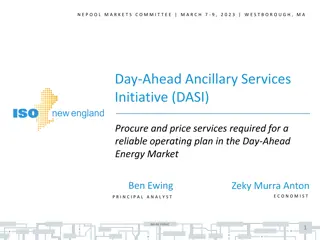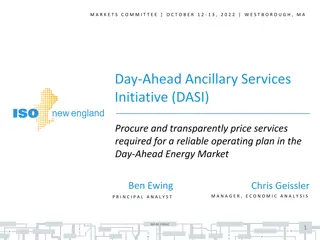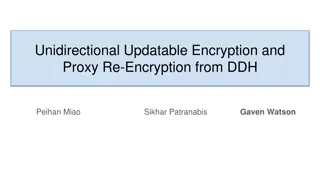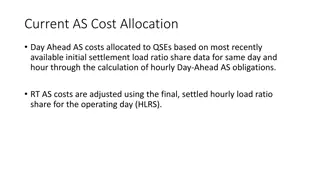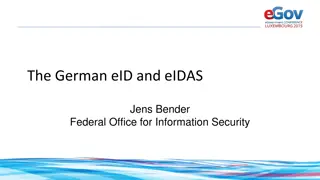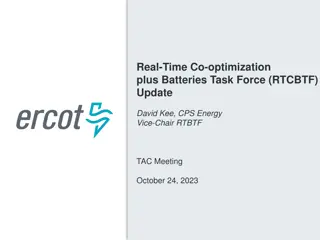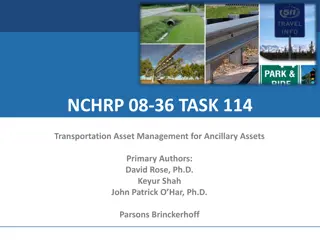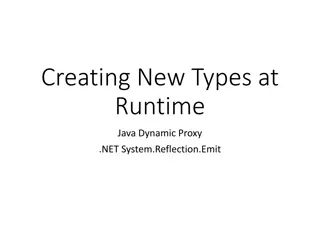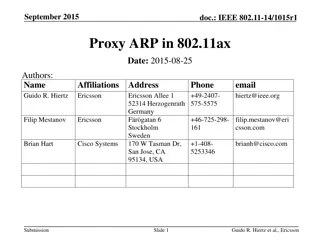
Proxy Ancillary Service Offer Parameters Discussion
Explore different approaches to setting floor values for proxy ancillary service offers, considering implications for ERCOT's recommendations and stakeholders' feedback to ensure proper alignment and incentives.
Download Presentation

Please find below an Image/Link to download the presentation.
The content on the website is provided AS IS for your information and personal use only. It may not be sold, licensed, or shared on other websites without obtaining consent from the author. If you encounter any issues during the download, it is possible that the publisher has removed the file from their server.
You are allowed to download the files provided on this website for personal or commercial use, subject to the condition that they are used lawfully. All files are the property of their respective owners.
The content on the website is provided AS IS for your information and personal use only. It may not be sold, licensed, or shared on other websites without obtaining consent from the author.
E N D
Presentation Transcript
Parameters for Proxy Ancillary Service Offer Floors 3rd Discussion David Maggio Principal, Market Design & Analytics RTCBTF November 13, 2024
Recap of the October Presentation and Discussion At the last meeting in October, we had looked at the different proposals for proxy Ancillary Offer Curve floor values. ERCOT s initial recommendation that the values be set to $0/MW per hour. An approach where the values were set at the Real-Time System-Wide Offer Cap (SWCAP), i.e., $2,000/MW per hour. $0/MW per hour Real-Time SWCAP Resources not offered by their QSE would generally be awarded after Resources that were offered Better incentives for QSEs that want to provide Ancillary Services to properly submit offers Value believed to be most in alignment with expected Real-Time Ancillary Service offer behavior Would not result in artificial Ancillary Service award shortages Pros* Could result in artificial Ancillary Service award shortages, particularly for ERCOT Contingency Reserve Service (ECRS) and Non-Spinning Reserve Service (Non-Spin) Could result in higher Ancillary Service prices not in alignment with energy prices, even when reserve capability is available Resources not being offered by their Qualified Scheduling Entity (QSE) could be awarded ahead of other Resources Less incentive for QSEs that want to provide Ancillary Services to properly submit offers Cons* * This table is intended to reflect a combination of ERCOT s thoughts and stakeholder feedback from previous task force discussions. 2 ERCOT Public
New Idea Being Evaluated (ASDC Derived) To try and find some compromise between the two approaches, a third approach was evaluated for the discussion today. Under this third approach, the proxy Ancillary Service Offer floor price can vary by Ancillary Service and is set equal to the minimum of: $2,000/MW per hour; and The point on the Ancillary Service Demand Curve (ASDC) that intersects with the quantity of Ancillary Services in the Ancillary Services Plan The thought is that this will: Reduce the likelihood that Resources not being offered by their QSE would be awarded ahead of other Resources. Relative to the $0/MW per hour approach Address the issue of artificial Ancillary Service award shortages and reduce the likelihood of high Ancillary Service prices not in alignment with energy prices and physical reserve capability. Relative to the Real-Time SWCAP approach 3 ERCOT Public
Illustration of the Third Approach Example from 6/20/24 Hour Ending 5 Value by Ancillary Service (in $/MW per hour) Regulation Up Service (Reg-Up): 2,000 Regulation Down Service (Reg-Down): 2,000 Responsive Reserve Service (RRS): 2,000 ECRS:1,270.71 Non-Spin: 12.30 Real-Time SWCAP Example from 6/20/24 Hour Ending 13 Value by Ancillary Service (in $/MW per hour) Reg-Up: 2,000 Reg-Down: 2,000 RRS: 2,000 ECRS:327.36 Non-Spin: 0.14 Real-Time SWCAP 4 ERCOT Public
Previously Shared Illustration (Prices): June 20, 2023 Proxy Offer Floor = $2,000/MW per hour Proxy Offer Floor = $0/MW per hour Energy Prices Energy Prices Limited scarcity and lower prices Limited scarcity and lower prices Ancillary Service Prices Ancillary Service Prices Higher prices and lower awards Limited scarcity and lower prices 5 ERCOT Public
Illustration for New Approach (Prices): June 20, 2023 Proxy Offer Floor = ASDC Derived Energy Prices Energy pricing perspective: There is limited differences between any of the three cases. Energy scarcity is limited to the late afternoon and evening hours where they eventually hover around $2,000/MWh. Limited scarcity and lower prices Ancillary Service pricing perspective: The new approach lands in the middle, but results are more in alignment with an SWCAP approach. Elevated Reg-Up, RRS, and ECRS prices during the middle part of the day with prices driven by the proxy Ancillary Service Offers. Ancillary Service Prices Higher prices but limited award scarcity 6 ERCOT Public
Previously Shared Illustration (Awards): June 20, 2023 Proxy Offer Floor = $2,000/MW per hour RTC Non-Spin Awards Proxy Offer Floor = $0/MW per hour RTC Non-Spin Awards 3,678 MW 1,278 MW Proxy Offer Floor = ASDC Derived RTC Non-Spin Awards For the new approach, the awards are largely in alignment with the Ancillary Service Plan during non-scarcity hours. Less extra Non-Spin procured in the morning and night hours, as compared to the $0/MW per hour floor approach. Unwarranted scarcity avoided with the new approach. 3,676 MW 7 ERCOT Public
Previously Shared Illustration (Awards): June 20, 2023 Proxy Offer Floor = $2,000/MW per hour RTC ECRS Awards 2,117 MW Proxy Offer Floor = $0/MW per hour RTC ECRS Awards 2,519 MW Proxy Offer Floor = ASDC Derived RTC ECRS Awards 2,519 MW For the new approach, awards largely in alignment with the Ancillary Service Plan during non-scarcity hours. Total awards very similar to results for the $0/MW per hour floor approach Again, unwarranted scarcity avoided with the new approach. 8 ERCOT Public
ASDCs with a Ramp-In for All Ancillary Service Products The updated recommendation is to leverage ASDCs for proxy Ancillary Services Offer floors. This recommendation strikes a balance between minimizing unwarranted Ancillary Service shortages and mitigating the concern of proxy offers undercutting QSE- submitted offers. While this new approach has merit, the specifics may be impacted by having ASDCs where there is also a ramp-in for Reg-Up, Reg-Down, RRS, and ECRS. For example, consider the case where the ASDC ramps to zero at a quantity equal the Ancillary Service Plan. The new approach would take us back to a condition where the proxy Ancillary Service Offer floor is $0/MW per hour. If there is agreement on using the ASDCs to derive floors, then we ll need to finalize the details for the proxy Ancillary Service Offer floors after any on-going ASDC discussion is further along. 9 ERCOT Public
Questions, Additional Discussion, and Next Steps ERCOT Public


